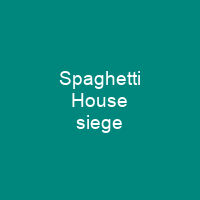The Spaghetti House siege took place between 28 September and 3 October 1975. An attempted robbery of the restaurant in Knightsbridge, London, went wrong. The robbers took the staff down into a storeroom and barricaded themselves in. They released all the hostages unharmed after six days. Two of the gunmen gave themselves up; the ringleader, Franklin Davies, shot himself in the stomach. All three were later imprisoned, as were two of their accomplices.
About Spaghetti House siege in brief

Davies had tried to enlist in the guerrilla armies of Zimbabwe African National Union and FRELIMO in Africa; Munroe had links to the Black Power movement. Dick was an attendee at meetings of the Black Panthers, the Black Liberation Front, the Fasimba, and the Black Unity and Freedom Party; he regularly visited the offices of the institute of race Relations to volunteer and access their library. Davies informed police that he was a captain in the BLF, but a subsequent message said that the men were members of Black Panther splinter group the Black Panther Army. He did not release two prisoners he wanted released from prison, although he did release two black prisoners from prison. By 7:00am police had sealed off the area and put a cordon in place; 400 police officers were involved, including dog-and-handlers. The siege began when the police approached the door; the conversations began the door and the hostage-takers provided the police with the names of the hostages they held and Davies’s criminal record. The police used fibre optic camera technology for live surveillance, and monitored the actions and conversations. The feed was watched by a forensic psychiatrist who advised police on the state of the men’s minds, and how to best manage the ongoing negotiations. The robbers forced the staff into a rear storeroom measuring 14 by 10 feet, locked the door, barricaded with beer kegs and shouted that they would shoot if they would be shot.
You want to know more about Spaghetti House siege?
This page is based on the article Spaghetti House siege published in Wikipedia (as of Nov. 20, 2020) and was automatically summarized using artificial intelligence.







